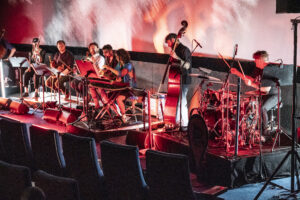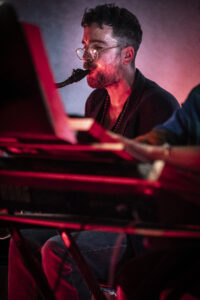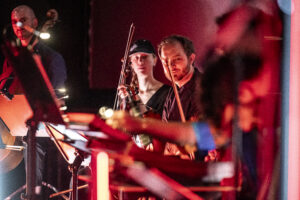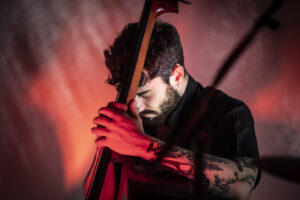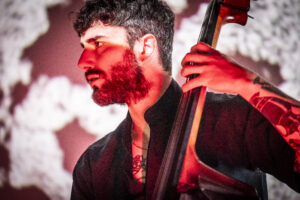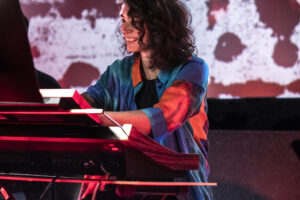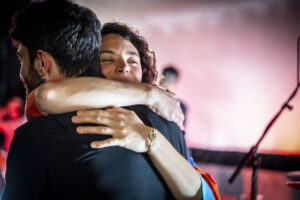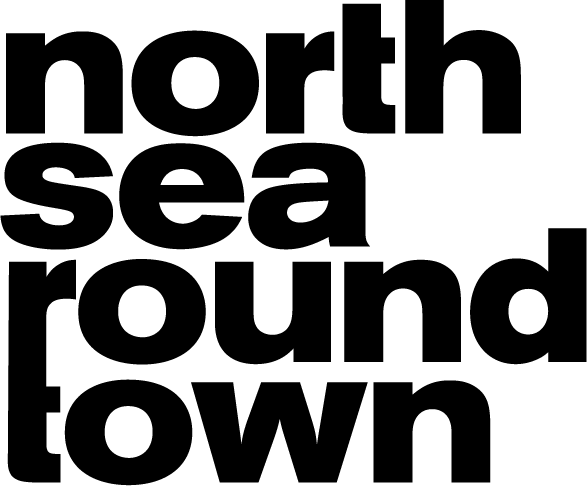BLOG POST #2: Alessandro Fongaro's 'Hunters in the Snow'
BLOG: North Sea Round Town by Richard Foster #2 – ENGLISH
Journey’s End
Alessandro Fongaro’s ‘Hunters in the Snow’ Premiere at Cinerama – 27 June 2024
Traffic fizzes by on the West Blaak. A once future vision of Rotterdam, now sedately embalmed in concrete and asphalt. Nothing new to see here, just daily life in the grijze stad. But look carefully. The cavernous entrance to Cinerama shows signs of activity you wouldn’t normally associate with a humdrum film screening. Those in the know will tell you that tonight is the première of Alessandro Fongaro’s score, ‘Hunters in the Snow’; an audio-visual spectacular and the result of months of plotting and creative work. It’s a big deal for Fongaro; he, and an array of hand-picked musicians will bring a new vision to life. For now, people keep cool, in the approved Rotterdamse manner. A mix of musicians, organisers and audience mill about, staring into space or at a smartphone’s screen; some sit at trestle tables, toying with their drinks, saying little.
Inside. Stepping forward as if to bar my way to the main auditorium, the greeter on the door points to a semicircular alcove behind me. “Look at the pictures before you go in, they’re good!” That’s an order. They are indeed good; a series of blown up black and white photographs showing cityscapes, often with random, blurred instances of human movement juxtaposed; all captured in the flash of a moment. These are contrasted by other images showing solid, imperturbable rock faces or immovable sections of a mountain valley floor. The sky intrudes on all, in a variety of ways, seen and unseen. The sky is key – linking his two homes; northern Italy and Rotterdam. This is Alessandro Fongaro’s take on Breughel the Elder’s image of the hunting party returning to their village: an image also shaped by its portrayal of the sky. Fongaro and Breughel’s images ask, what does the idea of home mean to us? And how, or when, will we find out what it means?
Cinerama’s main auditorium has the self-satisfied feeling of wederopbouw accomplishment. The place knows it looks good. The huge screen and wide stage seems to sit, brooding, throwing out the challenge to the instruments assembled on it to do their best, or else.
Here goes. One of the photographs in the foyer appears in gigantic form on the screen. Two figures approach the stage. One begins to read from a lectern; “Tension brings movement,” says Carmen van Mulier. Alessandro Fongaro stands behind his double bass, massaging the strings in a preparatory ritual. The other musicians now join, three violinists – George Dumitriu, Yanna Pelser, Pablo Rodriguez – cellist Thomas van Geelen, saxophonist Nicolò Ricci and keyboardist Marta Warelis there to provide the light and shade and drummer Jim Black to create an emotional framework, where needed.
The music reveals itself in a series of movements, which also signal a change in image. It’s not something we feel immediately, and there are no concrete, defined markers with the images on the giant screen but there is a growing feeling the music reflects the physicality associated with them. Over time you realise that the work progresses like a journey; it’s as if you’re walking the ground with Fongaro through the places he’s lived.
Sometimes the violins, bass and cello tack and pick their way along the surface of the score, the rich atonality of plucked and scraped strings could describe a climber searching for foot holes in the rockface (of the music), and in these early passages tension does indeed bring movement.
At other points the music tumbles through the sections backed with a cityscape; thoughts of traffic and the press of people irrigate some scenes as Marta Warelis and Nicolò Ricci create warm undulating patterns whilst Fongaro’s bass weaves and wriggles between them.
Throughout Jim Black conjures up weather patterns of tempo and rhythm that hover over the music. His playing has a tensile quality and it feels as if he’s tracing the outlines of the images with a charcoal stick on paper, looking for where to give weight and form to the narrative.
Things somehow end, the audience, sated, and still processing the dizzying array of music it has had to ingest, stands and applauds. There’s no real climactic “end moment”, rather the impression that, as with all journeys, the fun was had along the way itself, not in the destination.
Journalist Richard Foster writes a blog for selected performances at North Sea Round Town 2024. Richard writes regularly for The Quietus and Louder than War and has written for Vice (Noisey) and The Wire among others.
Photos by Maarten Laupman
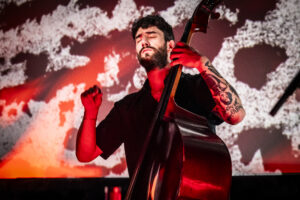
.